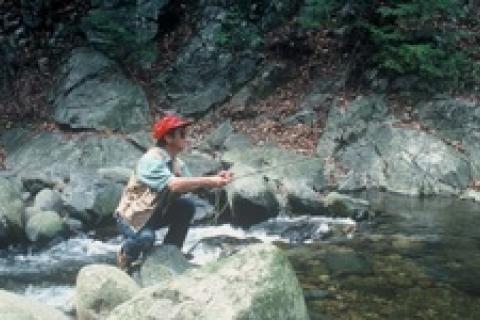
The brook trout reaches its ultimate potential in the cold waters of northern Canada, where orange-paunched fish of 4 and 5 pounds wallop huge streamers and large dry flies with a vengeance. I've experienced this type of fishing a number of times, and it's a blast. My most memorable trip was a five-day float trip in canoes down the Sutton River through Polar Bear Provincial Park in Ontario.
But the brook trout fishing most of us are familiar with takes place on a humbler scale, on headwater streams where the quarry is measured in inches instead of pounds and a foot-long fish is a trophy. Even though the brookies are much smaller in these settings, there's still much joy to be derived from fishing clear, cold, unsullied headwaters.
 The fish are usually a strenuous hike in from roads, which discourages other anglers and gives you the chance to enjoy solitude astream on many days. And numbers often make up for the fish's small size, with catches of several dozen trout a day not uncommon.
The fish are usually a strenuous hike in from roads, which discourages other anglers and gives you the chance to enjoy solitude astream on many days. And numbers often make up for the fish's small size, with catches of several dozen trout a day not uncommon.
Headwater brookies can be challenging to catch, too. That's not usually because they are selective in what they'll strike, but rather in other ways. The brush-choked, tight quarters in which they are found make casting difficult. The fast, gurgling water and twisting currents can create problems with drag. Pockets and eddies where the fish hold are tiny, requiring pinpoint accuracy in deliveries. And the shallow, clear waters make the fish skittish.
Always approach native brook trout quietly, with slow movements. Keep your profile low and wear drab-colored, or even camouflage clothing. Use the upstream approach most often, so you can work in close for a precise cast, yet avoid spooking the wary trout.
Since thick brush and trees often line small streams, accurate, drag-free deliveries require creative casting. By staying in midstream, you can sometimes shoot a backcast straight downstream behind you under the overhanging canopy of trees. Other times you might have to punch out a bow-and-arrow delivery from shore, or roll cast. Whatever cast you settle on for each piece of water, be sure it is delivered with slack in the leader, or the current will catch it and drag the fly. Any unnatural action of the offering like that will send native brookies scurrying back down into the bottom rocks to hide.
A long rod is a bad choice for these waters. I like a 6-7 foot rod taking a 3-5 weight line. A light, single action reel, double-taper floating line and 7- to 12-foot leader tapering to a 4X-7X tippet completes the rig.
Nymphs, streamers, dries and wets will all take brookies. Terrestrials such as beetles, ants and grasshoppers are especially effective, since much of their food tumbles in from land. Sometimes it also pays to tie on a pair of flies-either two wet flies or a nymph with a buoyant dry on a dropper as a strike indicator. In high water, try a streamer in size 6-12 worked back with sharp tugs of 6-12 inches and pauses in between.
- 2899 views

